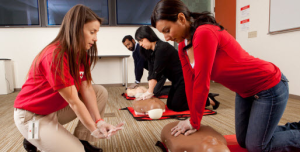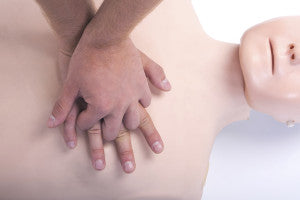“Ah, ha, ha, ha, stayin' alive, stayin' alive
Ah, ha, ha, ha, Stayin' ali-i-i-ive”
-- Stayin’ Alive, Bee Gees, 1977
An earworm of a 1977 disco song could help save lives. The beat of the Bee Gees song “Stayin’ Alive” happens to be about 100 beats per minute, or the rate a rescuer should push on a patient’s chest while doing cardiopulmonary resuscitation (CPR).
[caption id="attachment_19458" align="alignright" width="300"]

Learning CPR could help save lives - via American Red Cross[/caption]
Using this song and
a one-minute instructional video, the American Heart Association hopes to help more people learn basic, chest compression-only CPR. It can double or triple the chances for someone in cardiac arrest to survive, said Jennifer Merback, communications and marketing director for the American Heart Association of Utah and Nevada.
According to the American Heart Association,
88 percent of cardiac arrests take place at home. Yet fewer than 8 percent of people who suffer cardiac arrest outside the hospital survive. One main reason: only one in three cardiac arrest victims get CPR from a bystander.
“It’s that few seconds right before (emergency medical personnel) get there that are really important. It’s key to survival,” said Josh Schroeder, a firefighter-paramedic for the Lake City, Texas fire department.
Schroeder described one incident in which a woman at home in the middle of the night called 911 to report a family member wasn’t breathing. When a person’s heart stops, oxygenated blood stops flowing to the brain, which can begin to cause brain damage in a few minutes. Death can take place within 8 to 10 minutes,
according to the Mayo Clinic.
Fortunately, she knew what to do. She began CPR while she was on the phone.
“Because she called 911 immediately and because she jumped on chest compressions immediately, he survived,” Schroeder said.
Most Americans – 70 percent,
according to the American Heart Association – feel like they’d be helpless in a cardiac emergency because they don’t know CPR or have forgotten how to administer it.
“Obviously we’d love for people to get CPR certified,” Merback said. But a lack of formal training shouldn’t stop someone from trying to help.
So, here’s how someone without formal training can administer hands-only CPR to an older child or adult, without rescue breathing,
according to the American Red Cross. Some studies suggest that hands-only CPR can work as well as regular CPR, Merback said.
- Make sure the scene is safe, “so you’re not performing CPR around downed power lines,” said Merback.
- Check if the older child or adult is conscious or unconscious. If conscious, get permission to call 911 for any life-threatening condition. If unconscious, tap or shake the person’s shoulder and ask, loudly, “Are you OK?” Quickly look for breathing by gently tilting the person’s head back, lifting the chin and putting your ear close to their mouth. Occasional gasps are not breathing. If the person is breathing, keep the head back to keep the airway open and call 911.
- If you don’t get a response, call 911.
- If the person is unresponsive and not breathing, begin chest compressions. If you can, put the 911 dispatcher on speaker phone and begin chest compressions while on the phone. When possible, use disposable gloves. The Red Cross sells a key chain for $4 with a face shield for rescue breaths and disposable gloves.
Here’s how to do chest compressions.
-
 Put the heel of one hand on the center of the chest.
Put the heel of one hand on the center of the chest.
- Place the heel of the other hand on top of the first hand and lace your fingers together.
- Keeping arms straight, position your shoulders directly over your hands.
- Push hard and fast, keeping elbows locked and letting the chest rise completely before pushing down again. Compress the chest at least two inches and 100-120 times per minute. That’s as fast as the song “Stayin’ Alive.” Try singing it in your head, since you won’t be able to get it out of your brain anyway.
- Don’t stop except in one of the following situations: The person begins breathing on their own. Another trained responder arrives to help. EMS personnel arrive and take over. You’re too exhausted. An AED is ready. Or, the scene becomes unsafe.
People often don’t press fast or hard enough. Broken ribs are OK.
“You’re trying to squish their heart between their sternum and their backbone,” said Jon Kerkmann, a respiratory therapist who works at Utah Valley Regional Medical Center in Provo, Utah.
Mostly, don’t be afraid. Good Samaritan laws in most states protect people who try to help, Merback said.
“They’re already dead if you don’t do something. You’re not going to hurt them anymore,” said Kerkmann.
And if possible, take a CPR class and get trained in using an AED. Classes are available through the American Red Cross and the
American Heart Association.
What are some other life-saving skills you have? Let us know in the comments!

 Learning CPR could help save lives - via American Red Cross[/caption]
Using this song and a one-minute instructional video, the American Heart Association hopes to help more people learn basic, chest compression-only CPR. It can double or triple the chances for someone in cardiac arrest to survive, said Jennifer Merback, communications and marketing director for the American Heart Association of Utah and Nevada.
According to the American Heart Association, 88 percent of cardiac arrests take place at home. Yet fewer than 8 percent of people who suffer cardiac arrest outside the hospital survive. One main reason: only one in three cardiac arrest victims get CPR from a bystander.
“It’s that few seconds right before (emergency medical personnel) get there that are really important. It’s key to survival,” said Josh Schroeder, a firefighter-paramedic for the Lake City, Texas fire department.
Schroeder described one incident in which a woman at home in the middle of the night called 911 to report a family member wasn’t breathing. When a person’s heart stops, oxygenated blood stops flowing to the brain, which can begin to cause brain damage in a few minutes. Death can take place within 8 to 10 minutes, according to the Mayo Clinic.
Fortunately, she knew what to do. She began CPR while she was on the phone.
“Because she called 911 immediately and because she jumped on chest compressions immediately, he survived,” Schroeder said.
Most Americans – 70 percent, according to the American Heart Association – feel like they’d be helpless in a cardiac emergency because they don’t know CPR or have forgotten how to administer it.
“Obviously we’d love for people to get CPR certified,” Merback said. But a lack of formal training shouldn’t stop someone from trying to help.
So, here’s how someone without formal training can administer hands-only CPR to an older child or adult, without rescue breathing, according to the American Red Cross. Some studies suggest that hands-only CPR can work as well as regular CPR, Merback said.
Learning CPR could help save lives - via American Red Cross[/caption]
Using this song and a one-minute instructional video, the American Heart Association hopes to help more people learn basic, chest compression-only CPR. It can double or triple the chances for someone in cardiac arrest to survive, said Jennifer Merback, communications and marketing director for the American Heart Association of Utah and Nevada.
According to the American Heart Association, 88 percent of cardiac arrests take place at home. Yet fewer than 8 percent of people who suffer cardiac arrest outside the hospital survive. One main reason: only one in three cardiac arrest victims get CPR from a bystander.
“It’s that few seconds right before (emergency medical personnel) get there that are really important. It’s key to survival,” said Josh Schroeder, a firefighter-paramedic for the Lake City, Texas fire department.
Schroeder described one incident in which a woman at home in the middle of the night called 911 to report a family member wasn’t breathing. When a person’s heart stops, oxygenated blood stops flowing to the brain, which can begin to cause brain damage in a few minutes. Death can take place within 8 to 10 minutes, according to the Mayo Clinic.
Fortunately, she knew what to do. She began CPR while she was on the phone.
“Because she called 911 immediately and because she jumped on chest compressions immediately, he survived,” Schroeder said.
Most Americans – 70 percent, according to the American Heart Association – feel like they’d be helpless in a cardiac emergency because they don’t know CPR or have forgotten how to administer it.
“Obviously we’d love for people to get CPR certified,” Merback said. But a lack of formal training shouldn’t stop someone from trying to help.
So, here’s how someone without formal training can administer hands-only CPR to an older child or adult, without rescue breathing, according to the American Red Cross. Some studies suggest that hands-only CPR can work as well as regular CPR, Merback said.
 Put the heel of one hand on the center of the chest.
Put the heel of one hand on the center of the chest.
